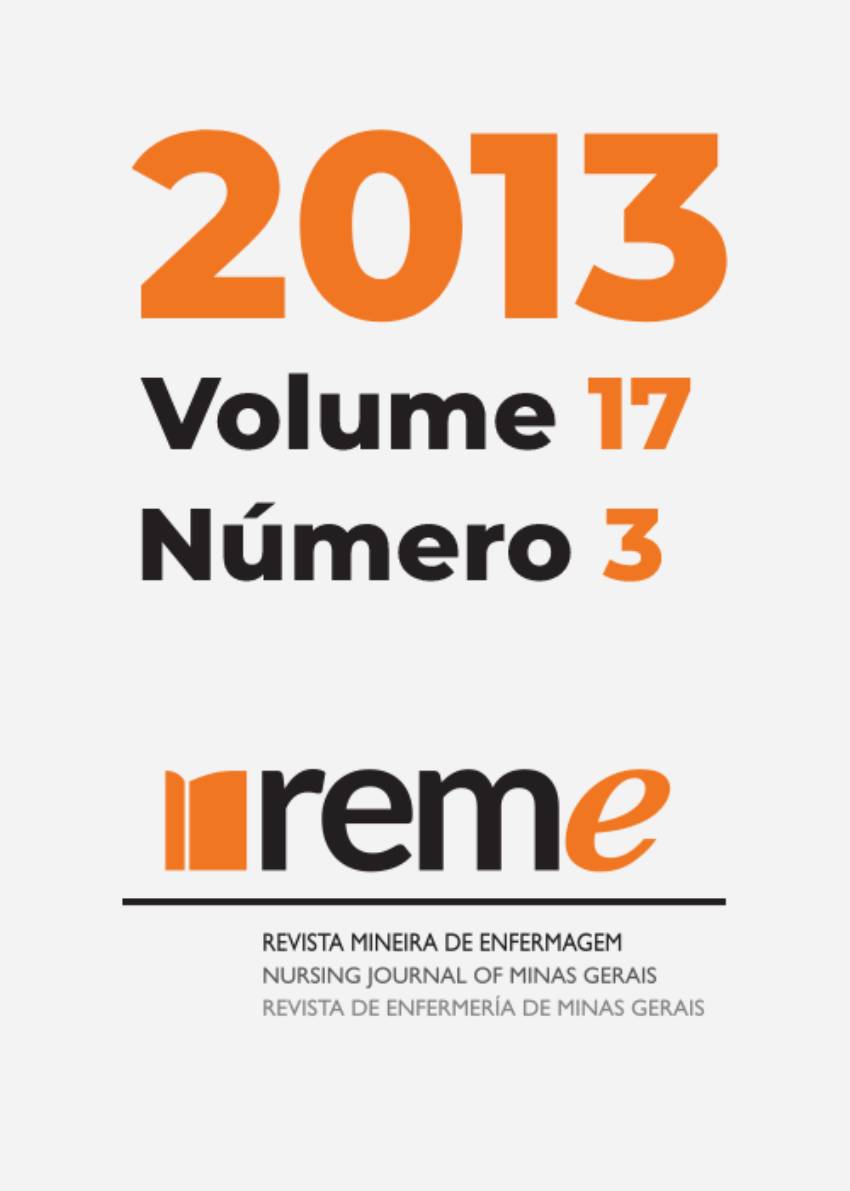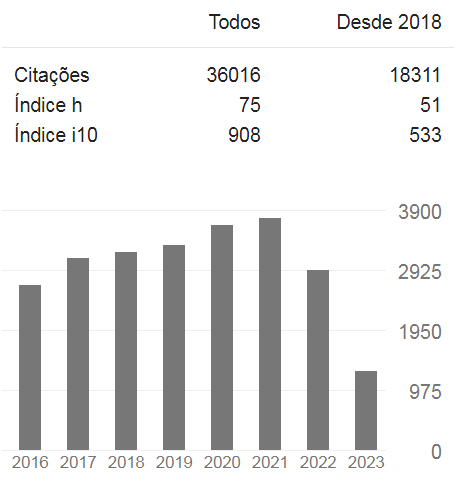Therapeutic outcome of patients at nutritional risk upon admission to a university hospital
DOI:
https://doi.org/10.35699/2316-9389.2013.50219Keywords:
Nutritional Assessment, Outcome, Inpatients, Risk, ScreeningAbstract
OBJECTIVE: to investigate the influence of nutritional risk, detected upon being admitted to a hospital, on therapeutic outcomes in patients. METHODS: This prospective cohort study was conducted with 495 patients admitted to the emergency clinic of a public hospital, where they were screened for nutritional risk based on the Nutritional Risk Screening 2002. At the end of hospitalization, the outcome, complications, and the presence of nutritional therapy were evaluated based on the medical records. RESULTS: Of the total patients, 53.9% were female, 71.3% were less than 60 years of age, and 11.7% had the therapeutic outcome of palliative care / death. According to Body Mass Index (BMI), 15.5% of the patients were classified as malnourished. Nutritional risk was found in 54.5%, which correlated strongly with the therapeutic outcome of palliative care/death (HR: 5.92, 95% CI: 2.68 to 13.08) as well as their components of increased nutritional requirements (HR: 3.33, 95% CI: 1.61 to 6.86) and impaired nutritional status (HR = moderate: 3.24, 95% CI: 1.31 to 8.00, severe = HR: 6.45, 95% CI: 2.36 to 17.63) after adjustment for potential confounding factors. CONCLUSION: The prevalence of nutritional risk detected in the sample was high, and its presence was related to a poor therapeutic outcome.Downloads
References
Correia MITD, Campos ACL. Prevalence of hospital malnutrition in Latin
America: the multicenter ELAN study. Nutrition. 2003;19(10):823-5.
Waitzberg DL, Caiaffa WT, Correia MITD. Hospital malnutrition: the
brazilian national survey (Ibranutri): a study of 4000 patients. Nutrition.
; 17(7-8):573-80.
Braunschweig C, Gomez S, Sheean PM. Impact of declines in nutritional
status on outcomes in adult patients hospitalized for more than 7 days. J Am
Diet Assoc. 2000; 100(11):1316-22.
Bavelaar JW, Otter CD, Bodegraven AA, Thijs A, Bokhorst-Schueren MA.
Diagnosis and treatment of (disease-related) in-hospital malnutrition: The
performance of medical and nursing staff. Clin Nutr. 2008; 27(3):431-8.
De Seta MH, O’Dwyer G, Henriques P, Sales GLP. Cuidado nutricional em
hospitais públicos de quatro estados brasileiros:Contribuições da avaliação
em saúde à vigilância sanitária de serviços. Ciênc Saúde Coletiva. 2010;
(S3):3413-22.
Alberda C, Graf A, McCargar L. Malnutrition: Etiology, consequences, and
assessment of a patient at risk. Best Pract Res Clin Gastroenterol. 2006;
(3):419-39.
Correia MITD, Waitzberg DL. The impact of malnutrition on morbidity,
mortality, length of hospital stay and cost evaluated through a multivariate
model analysis. Clin Nutr. 2003; 22(3):235-9.
Kondrup J, Allison SP, Elia M, Vellas B, Plauth M. ESPEN Guidelines for
Nutrition Screening 2002. Clin Nutr. 2003; 22(4):415-21.
Rasmussen HH, Holst M, Kondrup J. Measuring nutritional risk in hospitals.
Clin. Epidemiol. 2010; 2:209-16.
Kyle UG, Kossovsky MP, Karsegard VL, Pichard C. Comparison of tools for
nutritional assessment and screening at hospital admission: A population
study. Clin Nutrition. 2006; 25(3):409-17.
Brasil. Ministério da Saúde. Portaria n. 343/GM, de 7 de março de 2005.
Institui, no âmbito do SUS, mecanismos para implantação da assistência
de Alta Complexidade em Terapia Nutricional. Diário Oficial, Brasília, 8 mar.
Artigo 5º, p.1-1.
Raslan M, Gonzalez MC, Dias MCG, Nascimento M, Castro M, Marques P,
et al. Comparison of nutritional risk screening tools for predicting clinical
outcomes in hospitalized patients. Nutrition. 2010;26:721-6.
Sociedade Brasileira de Nutrição Parenteral e Enteral. Diretriz para Triagem e
Avaliação Nutricional. São Paulo: SBNPE; 2010.
Imoberdorf R, Meier R, Krebs P, Hangartner PJ, Hess B, Staubli M, et al.
Prevalence of undernutrition on admission to Swiss hospitals. Clin Nutrition.
; 29(1):38-41.
Schiesser M, Müller S, Kirchhoff P, Breitenstein S, Schäfer M, Clavien PA.
Assessment of a novel screening score for nutritional risk in predicting
complications in gastro-intestinal surgery. Clin Nutrition. 2008; 27(4):565-70.
Tsai AC, Shu-Fang Y, Jiun-Yi W. Validation of population-specific MiniNutritional Assessment with its long-term mortality-predicting ability:
results of a population-based longitudinal 4-year study in Taiwan. Br J
Nutrition. 2010; 104(1):93-9.
Saka B, Ozturk GB, Uzun S, Erten N, Genc S, Karan MA, et al. Nutritional risk
in hospitalized patients: impact of nutritional status on serum prealbumin.
Rev Nutrition. 2001; 24(1):89-98.
Amaral TF, Matos LC, Tavares MM, Subtil A, Martins R, Nazaré M, et al. The
economic impact of disease-related malnutrition at hospital admission. Clin
Nutrition. 2007; 26(6):778-84.
Organização Mundial da Saúde. Classificação estatística internacional de
doenças e problemas relacionados à saúde: 10a
revisão. São Paulo: Centro
Colaborador da OMS para a Classificação de Doenças em Português; 1993.
Oliveira MRM, Fogaça KCP, Leandro-Merhi VA. Nutritional status and
functional capacity of hospitalized elderly. Nutrition J. 2009; 54:1-8.
O’Flynn J, Peake H, Hickson M, Foster D, Frost G. The prevalence of
malnutrition in hospitals can be reduced: results from three consecutive
cross-sectional studies. Clin Nutrition. 2005; 24(6):1078-88.
Singh H, Watt K, Veitch R, Cantor M, Duerksen DR. Malnutrition is prevalent
in hospitalized patients: are housestaff identifying the malnourished patient?
Nutrition. 2006; 22(4):350-4.
Hiesmayr M, Schindler K, Pernicka E, Schuh C, Schoeniger-Hekele A, Bauer
P, et al. Decreased food intake is a risk factor for mortality in hospitalized
patients: the nutrition day survey 2006. Clin Nutrition. 2009; 28:484-91.
Rüfenacht U, Rühlin M, Wegmann M, Imoberdorf R, Ballmer PE. Nutritional
counseling improves quality of live and nutrient intake in hospitalized
undernourished patients. Nutrition. 2010; 26(1):53-60.
Raslan M, Gonzalez MC, Torrinhas RSMM, Ravacci GR, Pereira JCR,
Waitzberg DL. Complementarity of Subjective Global Assessment (SGA)
and Nutritional Risk Screening 2002 (NRS 2002) for predicting poor clinical
outcomes in hospitalized patients. Nutrition. 2011; 30:49-53.
Published
How to Cite
Issue
Section
License
Copyright (c) 2013 Reme: Revista Mineira de Enfermagem

This work is licensed under a Creative Commons Attribution 4.0 International License.






































